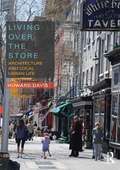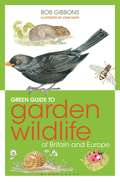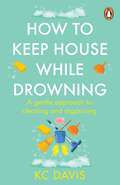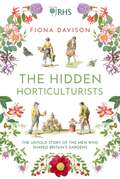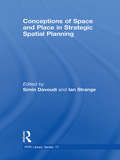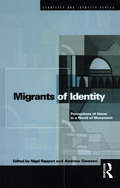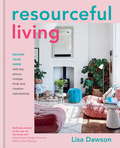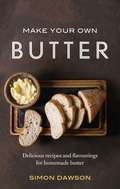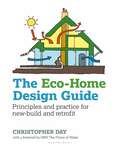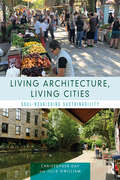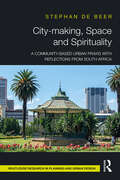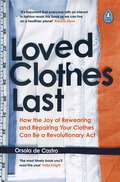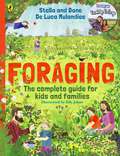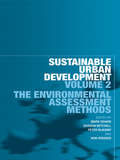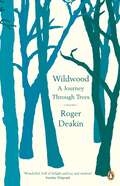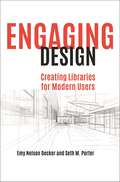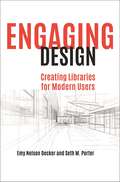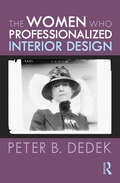- Table View
- List View
Living Over the Store: Architecture and Local Urban Life
by Howard DavisThe shop/house – the building combining commercial/retail uses and dwellings – appears over many periods of history in most cities in the world. This book combines architectural history, cross-cultural understandings and accounts of contemporary policy and building practice to provide a comprehensive account of this common but overlooked building. The merchant's house in northern European cities, the Asian shophouse, the apartment building on New York avenues, typical apartment buildings in Rome and in Paris – this variety of shop/houses along with the commonality of attributes that form them, mean that the hybrid phenomenon is as much a social and economic one as it is an architectural one. Professionals, city officials and developers are taking a new look at buildings that allow for higher densities and mixed-use. Describing exemplary contemporary projects and issues pertaining to their implementation as well as the background, cultural variety and urban attributes, this book will benefit designers dealing with mixed-use buildings as well as academics and students.
Living Over the Store: Architecture and Local Urban Life
by Howard DavisThe shop/house – the building combining commercial/retail uses and dwellings – appears over many periods of history in most cities in the world. This book combines architectural history, cross-cultural understandings and accounts of contemporary policy and building practice to provide a comprehensive account of this common but overlooked building. The merchant's house in northern European cities, the Asian shophouse, the apartment building on New York avenues, typical apartment buildings in Rome and in Paris – this variety of shop/houses along with the commonality of attributes that form them, mean that the hybrid phenomenon is as much a social and economic one as it is an architectural one. Professionals, city officials and developers are taking a new look at buildings that allow for higher densities and mixed-use. Describing exemplary contemporary projects and issues pertaining to their implementation as well as the background, cultural variety and urban attributes, this book will benefit designers dealing with mixed-use buildings as well as academics and students.
Working Cities: Architecture, Place and Production
by Howard DavisCities have historically supported production, commerce, and consumption, all central to urban life. But in the contemporary Western city, production has been hidden or removed, and commerce and consumption have dominated. This book is about the importance of production in the life of the city, and the relationships between production, architecture, and urban form. It answers the question: What will cities be like when they become, once again, places of production and not only of consumption? Through theoretical arguments, historical analysis, and descriptions of new initiatives, Working Cities: Architecture, Place and Production argues that contemporary cities can regain their historic role as places of material production—places where food is processed and things are made. The book looks toward a future that builds on this revival, providing architectural and urban examples and current strategies within the framework of a strong set of historically-based arguments. The book is illustrated in full colour with archival and contemporary photographs, maps, and diagrams especially developed for the book. The diagrams help illustrate the different variables of architectural space, urban location, and production in different historical eras and in different kinds of industries, providing a compelling visual understanding for the reader.
Green Guide to Garden Wildlife Of Britain And Europe (Green Guides)
by John Davis Bob GibbonsAimed at both the general reader and amateur naturalist, this guide offers information on observing and identifying 150 of the species most commonly encountered in gardens of Britain and Europe. Each species' habits, range and important characteristics are described, while colour paintings show each in detail. There are sections on and how to encourage wildlife into your garden and how to watch it. Sound advice on conservation issues is also offered. The book can be used as both a home reference and a pocket companion in the field.
How to Keep House While Drowning: A gentle approach to cleaning and organising
by KC DavisSimple tools to make home care easy when life is hardWhen you are neurodivergent, have undiagnosed ADHD or are struggling with your mental or physical health, keeping on top of the laundry pile and tackling dishes in the sink can feel like climbing a mountain. But it doesn’t have to be that way.Licensed therapist KC Davis has been there. Having relearnt the basics of self-care after an adult diagnosis of ADHD, she is here to revolutionise the way you look after your home and your mind. This gentle guide to staying afloat when life is tough shares practical strategies to create a functional home, make your space work for you rather than against you, and treat yourself with more compassion and kindness.KC’s philosophy: good enough is perfect. With her help, your home will feel like a sanctuary again.‘A kind and understanding book to help us all feel a little better about ourselves and how we live’ Helen Russell, bestselling author of The Year of Living Danishly
The Hidden Horticulturists: The Untold Story of the Men who Shaped Britain’s Gardens
by Fiona Davison'Delightful... The Hidden Horticulturists pulsates with the extraordinary energy and excitement of the time.' Daily MailChosen as one of the Sunday Telegraph's 'Top Ten Gardening Books of the Year' _____________________The untold story of the remarkable young men who played a central role in the history of British horticulture and helped to shape the way we garden today.In 2012, whilst working at the Royal Horticultural Society's library, Fiona Davison unearthed a book of handwritten notes that dated back to 1822. The notes, each carefully set out in neat copperplate writing, had been written by young gardeners in support of their application to be received into the Society's Garden.Amongst them was an entry from the young Joseph Paxton, who would go on to become one of Britain's best-known gardeners and architects. But he was far from alone in shaping the way we garden today and now, for the first time, the stories of the young, working-class men who also played a central role in the history of British horticulture can be told.Using their notes, Fiona Davison traces the stories of a selection of these forgotten gardeners whose lives would take divergent paths to create a unique history of gardening. The trail took her from Chiswick to Bolivia and uncovered tales of fraud, scandal and madness - and, of course, a large number of fabulous plants and gardens. This is a celebration of the unsung heroes of horticulture whose achievements reflect a golden moment in British gardening, and continue to influence how we garden today.
Conceptions of Space and Place in Strategic Spatial Planning (RTPI Library Series)
by Simin Davoudi Ian StrangeBringing together authors from academia and practice, this book examines spatial planning at different places throughout the British Isles. Six illustrative case studies of practice examine which conceptions of space and place have been articulated, presented and visualized through the production of spatial strategies. Ranging from a large conurbation (London) to regional (Yorkshire and Humber) and national levels, the case studies give a rounded and grounded view of the physical results and the theory behind them. While there is widespread support for re-orienting planning towards space and place, there has been little common understanding about what constitutes ‘spatial planning’, and what conceptions of space and place underpin it. This book addresses these questions and stimulates debate and critical thinking about space and place among academic and professional planners.
Conceptions of Space and Place in Strategic Spatial Planning (RTPI Library Series)
by Simin Davoudi Ian StrangeBringing together authors from academia and practice, this book examines spatial planning at different places throughout the British Isles. Six illustrative case studies of practice examine which conceptions of space and place have been articulated, presented and visualized through the production of spatial strategies. Ranging from a large conurbation (London) to regional (Yorkshire and Humber) and national levels, the case studies give a rounded and grounded view of the physical results and the theory behind them. While there is widespread support for re-orienting planning towards space and place, there has been little common understanding about what constitutes ‘spatial planning’, and what conceptions of space and place underpin it. This book addresses these questions and stimulates debate and critical thinking about space and place among academic and professional planners.
Sketching Interiors at the Speed of Thought: - with STUDIO
by Jim Dawkins Jill Pable"Books such as this are imperative for our students to learn skills taught as part of a class. Although this book is geared towards interior design, the content and skills development will be as important to students in garden design and soft furnishings alike." Vicky McClymont, National Design Academy, Nottingham, UKUse detailed, step-by-step techniques to create quick perspective sketches. The book will help you develop important skills for ideation and client communication. Exercises cover a wide range of elements including doors, windows, stairs, millwork, furnishings, and ceilings, as well as more advanced topics like shade and shadowing, scene composition, contrast, and materials and textures.-Interactive digital content, including demonstration videos and self-assessment exercises-Presented in three parts: beginning, intermediate, and advanced sketching techniques-Sketching Gallery shows the work of practitioners allowing you to enhance your stylePLEASE NOTE: Purchasing or renting this ISBN does not include access to the STUDIO resources that accompany this text. To receive free access to the STUDIO content with new copies of this book, please refer to the book + STUDIO access card bundle ISBN 9781501323508.
Migrants of Identity: Perceptions of 'Home' in a World of Movement
by Andrew Dawson Nigel RapportGlobal movement is commonly characterized as one of the quintessential experiences of our age. Market forces, territorial conflicts and environmental changes uproot an increasing number of people, while mass communication, travel, tourism, and a global market of commodities, texts, tastes, fashions and ideologies place individuals more than ever in a global arena. As traditional conceptions of individuals as members of stationary, fixed and separate societies and cultures no longer convince, to what extent does movement become central to individuals' self-conceptions? How do people cultivate, negotiate, nurture and maintain an identity? To what extent do individuals become ‘migrants of identity' whose home is movement?Defining ‘home' as ‘where one best knows oneself', this pioneering book explores the various ways in which people perceive themselves to be ‘at home' in today's world. Through a series of case studies, authors show that for a world of travellers, labour migrants, exiles and commuters, ‘home' comes to be found in behavioural routines and techniques, in styles of dress and address, in memories, myths and stories, in jokes and opinions. In short, people who live their lives in movement make sense of their lives as movement.
Resourceful Living: Revamp Your Home With Key Pieces, Vintage Finds And Creative Repurposing
by Lisa DawsonIt's often thought that restyling your space comes with a hefty price tag and unavoidable waste. But in Resourceful Living, award-winning interiors blogger Lisa Dawson shows how, with a little creativity, you can revamp your home with existing pieces, vintage finds and key purchases. The clever ideas in this beautiful book cover:- The most important ways we use our homes, from eating to sleeping, living and working.- The Basics of steering clear of interiors 'fast fashion', multi-purposing furniture and making the most of what you have.- Styling Your Home with simple solutions for re-imagining each room, from gallery walls to home bars, repainted storage to retro accessories.Including her top ten key vintage buys and tips for in-store and online thrifting, Lisa's inspiring advice shares the fun of creative sourcing as a more sustainable way to keep your home feeling fresh.'Resourceful Living feels like reading a recipe book, not only because of the delicious interiors images, but because of the simple ingredients and easy methods that are shared to achieve beautiful living spaces for yourself.' Melanie Sykes'I've been a long-time fan and follower of Lisa's interiors tips. This book really is super practical as well as beautiful - perfect for anyone looking to be more interiors savvy.' Rachel Khoo
Make Your Own Butter: Delicious recipes and flavourings for homemade butter
by Simon DawsonIf it's fun, funky, jazzy and is to do with butter, it's in this book. From how to make butter at home, to where to use it, and if that raises your 'yeah, sure, I know about butter, pal' eyebrows, this book is going to surprise and delight you into next week.Split into four sections:· What you need to know· Making butter· Getting creative· RecipesMake Your Own Butter will· Whip you into a frenzy so you can't wait to start churning· Thrill and surprise with its sheer range of buttery creations like cocktails and beauty products· Enthral with QI style buttery facts· Equip you with a life skill to be passed on to others
The Eco-Home Design Guide: Principles and practice for new-build and retrofit (Sustainable Building #8)
by Christopher DayThe key principles of designing a pleasant, comfortable and healthy eco-home, with a foreword written by HRH The Prince of Wales, now King Charles III. Designing an eco-home is much more about working with your house's location and situation than relying on intrusive technology and hi-tech materials. With the soaring energy bills and the climate crisis, it is now more important than ever to invest in a home that is considerate of keeping heat in.In this handbook, architect Christopher Day draws on his extensive experience to explain the key principles of eco-home design, using common-sense methods. Packed full of practical information, it includes several case studies of eco-homes, reviewing (with hindsight) what worked well and what could have been better. There is also guidance on how to generate energy, upgrading old buildings, and site planning.With beautifully hand-drawn illustrations, Christopher explores how to use local topography, combined with landscaping, to improve your home's microclimate and keep your house dry and warm in the winter, and cool in the summer. There are also handy tips on how to minimise hidden environmental impacts, and ideas on ways to make your home a safe and healthy place, both emotionally and physically. The Eco-Home Design Guide is essential for anyone who wants to create a attractive, environmentally friendly home that is in harmony with its location.
Living Architecture, Living Cities: Soul-Nourishing Sustainability
by Christopher Day Julie GwilliamIt’s widely accepted that our environment is in crisis. Less widely recognized is that three quarters of environmental damage is due to cities – the places where most of us live. As this powerful new book elucidates, global sustainability is therefore directly dependent on urban design. In Living Architecture, Living Cities Christopher Day and Julie Gwilliam move beyond the current emphasis on technological change. They argue that eco-technology allows us to continue broadly as before and only defers the impending disaster. In reality, most negative environmental impacts are due to how we live and the things we buy. Such personal choices often result from dissatisfaction with our surroundings. As perceived environment has a direct effect on attitudes and motivations, improving this can achieve more sustainable lifestyles more effectively than drastic building change – with its notorious performance-gap limitations. As it’s in places that our inner feelings and material reality interact, perceived environment is place-based. Ultimately, however, as the root cause of unsustainability is attitude, real change requires moving from the current focus on buildings and technology to an emphasis on the non-material. Featuring over 400 high quality illustrations, this is essential reading for anyone who believes in the value and power of good design. Christopher Day’s philosophy will continue to inspire students with an interest in sustainable architecture, urban planning and related fields.
Living Architecture, Living Cities: Soul-Nourishing Sustainability
by Christopher Day Julie GwilliamIt’s widely accepted that our environment is in crisis. Less widely recognized is that three quarters of environmental damage is due to cities – the places where most of us live. As this powerful new book elucidates, global sustainability is therefore directly dependent on urban design. In Living Architecture, Living Cities Christopher Day and Julie Gwilliam move beyond the current emphasis on technological change. They argue that eco-technology allows us to continue broadly as before and only defers the impending disaster. In reality, most negative environmental impacts are due to how we live and the things we buy. Such personal choices often result from dissatisfaction with our surroundings. As perceived environment has a direct effect on attitudes and motivations, improving this can achieve more sustainable lifestyles more effectively than drastic building change – with its notorious performance-gap limitations. As it’s in places that our inner feelings and material reality interact, perceived environment is place-based. Ultimately, however, as the root cause of unsustainability is attitude, real change requires moving from the current focus on buildings and technology to an emphasis on the non-material. Featuring over 400 high quality illustrations, this is essential reading for anyone who believes in the value and power of good design. Christopher Day’s philosophy will continue to inspire students with an interest in sustainable architecture, urban planning and related fields.
City-making, Space and Spirituality: A Community-Based Urban Praxis with Reflections from South Africa
by Stéphan de BeerThis book is about the soul of the city, embodied in its spaces and people. It traces dynamics in inner city neighbourhoods of South Africa’s post-apartheid capital, Pretoria. Viewing the city through its most vulnerable people and places, it recognizes that urban space is never neutral and shaped by competing value frameworks. The first part of the book invites planners, city-makers, and ordinary urban citizens, to consider a new self-understanding, reclaiming their agency in the city-making process. Through the metaphor of "becoming like children", planning practice is deconstructed and re-imagined. A praxis-based methodology is presented, cultivating four distinct moments of entering, reading, imagining and co-constructing the city. After deconstructing urban spaces and discourses, the second part of the book explores a concrete spirituality and ethic of urban space. It argues for a shift from planning as technocracy, to planning as immersed, participatory artistry: opening up to the "genius" of space, responsive to urban cries, and joining to construct new, soul-full spaces. Local communities and interconnected movements become embodiments of urban alternatives – through resistance and reconstruction; building on local assets; animating local reclamations; and weaving nets of hope that will span the entire city. Providing a concrete methodology for city-making that is rooted in a community-based urban praxis, this book will be of interest to urban planning researchers, professional planners and designers and also grass-root community developers or activists.
City-making, Space and Spirituality: A Community-Based Urban Praxis with Reflections from South Africa
by Stéphan de BeerThis book is about the soul of the city, embodied in its spaces and people. It traces dynamics in inner city neighbourhoods of South Africa’s post-apartheid capital, Pretoria. Viewing the city through its most vulnerable people and places, it recognizes that urban space is never neutral and shaped by competing value frameworks. The first part of the book invites planners, city-makers, and ordinary urban citizens, to consider a new self-understanding, reclaiming their agency in the city-making process. Through the metaphor of "becoming like children", planning practice is deconstructed and re-imagined. A praxis-based methodology is presented, cultivating four distinct moments of entering, reading, imagining and co-constructing the city. After deconstructing urban spaces and discourses, the second part of the book explores a concrete spirituality and ethic of urban space. It argues for a shift from planning as technocracy, to planning as immersed, participatory artistry: opening up to the "genius" of space, responsive to urban cries, and joining to construct new, soul-full spaces. Local communities and interconnected movements become embodiments of urban alternatives – through resistance and reconstruction; building on local assets; animating local reclamations; and weaving nets of hope that will span the entire city. Providing a concrete methodology for city-making that is rooted in a community-based urban praxis, this book will be of interest to urban planning researchers, professional planners and designers and also grass-root community developers or activists.
Loved Clothes Last: How the Joy of Rewearing and Repairing Your Clothes Can Be a Revolutionary Act
by Orsola de Castro'It's important that everyone with an interest in fashion reads this book so we can live on a healthier planet' Arizona Muse 'The most timely book you'll read this year' India Knight* * * * * Running out of space for the clothes you can't stop buying? Curious about how you can make a difference to the environmental challenges our planet faces? Join Orsola's care revolution and learn to make the clothes you love, last longer.This book will equip you with a myriad of ways to mend, rewear and breathe new life into your wardrobe to achieve a more sustainable lifestyle. By teaching you to scrutinise your shopping habits and make sustainable purchases, she will inspire you to buy better, care more and reduce your carbon footprint by simply making your loved clothes last longer.Following Orsola's practical tips to lavish care and attention on the clothes you already own will not only have a positive environmental impact, but will be personally rewarding too: hand wash, steam and spot clean your clothes, air dry instead of tumble drying, or revive your clothes by sewing or crocheting.Fast fashion leaves behind a trail of human and environmental exploitation. Our wardrobes don't have to be the finish line; they can be a starting point. We can all care, repair and rewear. Do you accept the challenge?* * * * *'An incredibly thoughtful, must-read guide' Kenya Hunt'A must read for anyone who wants to understand the fashion industry as an outsider and wants direction as to where we go next' Aja Barber
Foraging: The fun and easy guide to the great outdoors
by Stella and De Luca MulandieeFrom the writers behind the extraordinary Knowledge to Forage comes an incredible guide to the great outdoors . . .Welcome to the world of foraging.Have you ever been on a long (and probably boring) walk through woods or fields, or even the streets around where you live?If you have, then all around you are undiscovered secrets. A whole world of nature and plants and flowers just waiting to be found.In this amazing book, we'll tell you all about how you can become an expert in foraging - which is a way to find incredible food, medicines and even soaps in the natural world around you.After reading this book, you'll be able to:- Find the best berries and plants for making yummy foods- Learn about the incredible stories hidden in the flowers and plants and trees you see every day (and some you might never have spotted).- Impress your friends with your incredible knowledge of the natural world - and help them protect it!With handy tips and colourful illustrations, Family Foraging is a comprehensive guide to nature and foraging, which will allow children to explore the great outdoors with friends and families.*Includes a full and comprehensive safety guide*
Sustainable Urban Development Volume 2: The Environmental Assessment Methods (Sustainable Urban Development Series)
by Mark Deakin Gordon Mitchell Peter Nijkamp Ron VreekerIn this book, the second of a three-volume series, leading authorities on the methodology of environmental assessment provide a unique insight into questions of critical importance to sustainable urban development. Using the framework and protocols set out in Volume 1, Volume 2 examines how well the environmental assessment methods evaluate the ecological integrity of urban development and equity of the resulting resource distribution. The examination focuses on: the instruments of environmental assessment approaches to environmental assessment based in systems-thinking methods for environmental, economic and social assessments their use in evaluating the sustainability of urban development. The Sustainable Urban Development Series contains the research and debate of the BEQUEST (Building, Environmental Quality Evaluation for Sustainability) network funded by the European Commission. Together the books provide a framework, set of protocols, environmental assessment methods and toolkit for policy makers, academics, professionals and advanced level students in urban planning and studies, as well as other areas of the built environment.
Sustainable Urban Development Volume 2: The Environmental Assessment Methods (Sustainable Urban Development Series #Vol. 2)
by Mark Deakin Gordon Mitchell Peter Nijkamp Ron VreekerIn this book, the second of a three-volume series, leading authorities on the methodology of environmental assessment provide a unique insight into questions of critical importance to sustainable urban development. Using the framework and protocols set out in Volume 1, Volume 2 examines how well the environmental assessment methods evaluate the ecological integrity of urban development and equity of the resulting resource distribution. The examination focuses on: the instruments of environmental assessment approaches to environmental assessment based in systems-thinking methods for environmental, economic and social assessments their use in evaluating the sustainability of urban development. The Sustainable Urban Development Series contains the research and debate of the BEQUEST (Building, Environmental Quality Evaluation for Sustainability) network funded by the European Commission. Together the books provide a framework, set of protocols, environmental assessment methods and toolkit for policy makers, academics, professionals and advanced level students in urban planning and studies, as well as other areas of the built environment.
Wildwood: A Journey Through Trees
by Roger DeakinRoger Deakin's Wildwood is a much loved classic of nature writingWildwood is about the element wood, as it exists in nature, in our souls, in our culture and our lives.From the walnut tree at his Suffolk home, Roger Deakin embarks upon a quest that takes him through Britain, across Europe, to Central Asia and Australia, in search of what lies behind man's profound and enduring connection with wood and with trees.Meeting woodlanders of all kinds, he lives in shacks and cabins, travels in search of the wild apple groves of Kazakhstan, goes coppicing in Suffolk, swims beneath the walnut trees of the Haut-Languedoc, and hunts bush plums with Aboriginal women in the outback.Perfect for fans of Robert Macfarlane and Colin Tudge, Roger Deakin's unmatched exploration of our relationship with trees is autobiography, history, traveller's tale and incisive work in natural history. It will take you into the heart of the woods, where we go 'to grow, learn and change''Enthralling' Will Self, New Statesman'Extraordinary . . . some of the finest naturalist writing for many years' Independent'Masterful, fascinating, excellent' Guardian'An excellent read - lyrical and literate and full of social and historical insights of all kinds' Colin Tudge, Financial Times'Enchanting, very funny, every page carries a fascinating nugget. Should serve to make us appreciate more keenly all that we have here on earth . . . one of the greatest of all nature writers' Craig Brown, Mail on Sunday'Breathtaking, vividly written . . . reading Wildwood is an elegiac experience' Sunday TimesRoger Deakin, who died in August 2006, shortly after completing the manuscript for Wildwood, was a writer, broadcaster and film-maker with a particular interest in nature and the environment. He lived for many years in Suffolk, where he swam regularly in his moat, in the river Waveney and in the sea, in between travelling widely through the landscapes he writes about in Wildwood. He is the author of Waterlog, Wildwood and Notes from Walnut Tree Farm.
Engaging Design: Creating Libraries for Modern Users
by Emy Nelson Decker Seth M. PorterThis book demonstrates how aesthetics, design elements, and visual literacy can be implemented in the library to enhance spaces, programs, services, instruction, and outreach so that your library will appeal to all users.Libraries have come to accept that they must rethink how they appeal to users, and harnessing the power of design can be a powerful means for addressing the changing needs of the community. Decker and Porter introduce "engaging design"—an umbrella term that incorporates multiple design frameworks with a focus on a three-prong approach: aesthetics, design thinking, and service design. These frameworks can be used to guide design choices that will aid in teaching and engaging current and potential library users.In the course of a lively and interesting narrative, Engaging Design introduces basic concepts of aesthetics and good design and explores examples of its successful uses in the academic, public, and special library. It provides simple steps for implementing subtle, but powerful, techniques to improve instruction, human-computer interaction, e-learning, public services spaces, wayfinding signage, and all manner of library programs, events, and services. In addition, the authors recommend easy-to-implement best practices that will help librarians to enhance library-goers' experience. Library administrators will also look to this book for assistance in best addressing the needs of the modern library user.
Engaging Design: Creating Libraries for Modern Users
by Emy Nelson Decker Seth M. PorterThis book demonstrates how aesthetics, design elements, and visual literacy can be implemented in the library to enhance spaces, programs, services, instruction, and outreach so that your library will appeal to all users.Libraries have come to accept that they must rethink how they appeal to users, and harnessing the power of design can be a powerful means for addressing the changing needs of the community. Decker and Porter introduce "engaging design"—an umbrella term that incorporates multiple design frameworks with a focus on a three-prong approach: aesthetics, design thinking, and service design. These frameworks can be used to guide design choices that will aid in teaching and engaging current and potential library users.In the course of a lively and interesting narrative, Engaging Design introduces basic concepts of aesthetics and good design and explores examples of its successful uses in the academic, public, and special library. It provides simple steps for implementing subtle, but powerful, techniques to improve instruction, human-computer interaction, e-learning, public services spaces, wayfinding signage, and all manner of library programs, events, and services. In addition, the authors recommend easy-to-implement best practices that will help librarians to enhance library-goers' experience. Library administrators will also look to this book for assistance in best addressing the needs of the modern library user.
The Women Who Professionalized Interior Design
by Peter DedekThe Women Who Professionalized Interior Design explores the history of interior decorating and design from the late nineteenth century to the present, highlighting the careers and contributions of significant American female interior designers who were instrumental in the creation of the field of residential and commercial interior design in the United States. This book explores how interior design emerged as a distinct, paying occupation in the nineteenth century thanks to a growing middle class and an increase in available cheap household goods following the Industrial Revolution. Focusing primarily on the period from 1905 to 1960, it addresses the complex relationships among professionals in the design fields, the social dynamics of designer-client relationships, and how class, culture, and family influenced their lives and careers. The book emphasizes significant female interior decorators and writers on design including Candace Wheeler, Elsie de Wolfe, Edith Wharton, Nancy McClelland, Ruby Ross Wood, Dorothy Draper, Eleanor McMillen Brown, and Sister Parish, all of whom are underrepresented in the historical record, relating their stories within the context of the history of design and architecture. This book is an ideal and concise resource for students and faculty of interior design and women’s history.
